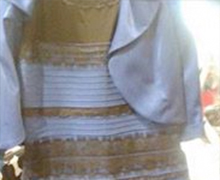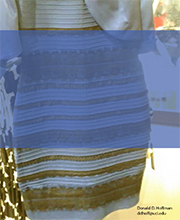What color is the dress?

What color is the dress?
- February 27, 2015
- UCI cognitive scientists weigh in on color perception debate
-----
It’s all about the dress. For the past 24 hours, you’d be hard pressed to find a topic
that has more people at odds than the color combo of a seemingly simple little number
that surfaced on social media. Is it brown and white? Is it blue and black? How can
so many people see the same photo and come up with such adamantly different results?
To help solve the mystery, two UCI experts on visual perception and recognition are
weighing in.  Alyssa Brewer
Alyssa Brewer
Assistant Professor, Cognitive Sciences, UCI
Ph.D. Stanford University | M.D. Stanford University
I love visual illusions! My lab's motto is 'perception is more than what meets the
eye.'
Color vision is much more complicated than people often realize. Color vision starts
in the eye with the three types of cone photoreceptors. These cones respond to peak
wavelengths of red, green, and blue light. However, these cones don't just send signals
of a specific color hue straight to our conscious brain. Instead, they are wired up
into what we call an 'opponent color' system. Information about red and green hues
enter the visual system as red vs. green while blue enters as blue vs. yellow (red
+ green). This means that red cones and green cones may activate or inhibit the same
neuron at the next level of retinal wiring, respectively. For blue vs. yellow, the
red and green cones combine signals and then interact with the blue cone signals.
In our lab, we are using functional MRI to study where in the brain color information
is processed. Science is still trying to figure out where in the brain these signals
change from these comparisons of colors (red vs. green; blue vs. yellow) to our conscious
interpretation of specific colors. So far, no one has shown a 'purple neuron,' for
example. However, several types of color illusions can demonstrate how constructive
the brain can be for vision. For example, we all experience something called 'color
constancy.' Because it is very beneficial for our survival to be able to identify
objects with specific colors as the same despite changes in ambient lighting, we have
evolved the ability to interpret the colors in a scene based not only on the specific
wavelengths of light reflecting off a particular spot on an object, but also incorporate
information like the neighboring colors and background lighting. Our brain can interpret
a range of initial wavelengths as different colors based on the rest of the scene.
One illusion that demonstrates how our brain adjusts our color interpretation of an
object based on the surroundings and the lighting of the scene is shown in this video:
https://www.youtube.com/watch?v=hvgOOKBvyQU.
Differences in color vision can arise between people, and even between your own eyeballs!
Differences in the number and patterns of the three cone colors can differ between
your own eyeballs, and definitely differ between people. You can imagine that if one
person has mostly green cones and one has mostly red cones, differences in how the
initial color signals are processed may arise. A small number of women actually have
four types of cones, due to a mutation in one cone gene that makes three cones span
the red and green wavelengths rather than two. These 'tetrachromats' are able to define
more color hues than the rest of us with normal 'trichromatic' vision. Past the early
stages of color differences, people may have different amounts of their brains devoted
to processing color. Differences can also arise based on our experiences with color.
Younger children tend to have a harder time seeing some of the color illusions. Even
higher cognitive tasks like the language we learn as a child to describe colors, and
how these languages divide up different hues, can affect our interpretation of a specific
color!
In terms of the dress picture, many of these types of differences can be coming into
play. The colors of the dress and the shading effects appear to fall within a specific
set of hues that may be affected by the cone patterns in each eyeball and also by
changes in the type of illumination in the room in which you are viewing the image.
I suggest checking out the dress with each eye, in sunlight, in the dark, and under
fluorescent lights. Zooming in to close up views of each color of the dress may also
change the image for some, as the color information of the surrounding image is taken
away. Remember, your eye is not simply like a camera - your individual brain is crucial
in creating your actual perception!
I saw the dress as blue/dark brown initially, but was able to see white/gold under
different lighting.
----- Don Hoffman
Don Hoffman
Professor, Cognitive Sciences, UCI
Ph.D. Massachusetts Institute of Technology Our perception of the color of objects is a complex construction by our visual system.
It must decide what is the color of the light shining on the object and what is the
color of the object itself. If the visual system changes what it thinks the color
of the light is, then it must change the color of what it thinks the color of the
object is. In the white-gold or blue-black dress illusion, the visual systems of different
people make different decisions about the color of the light shining on the dress.
Some decide it has a bluer cast than others. Those who decide it has a bluer cast
see white-gold, the others see blue-black. To demonstrate this, I have color adjusted
the image by removing the overall blue cast, and then I have added a blue transparency
layer over part of the dress. The transparent layer shows the interpretation in which
the light source has a blue cast. The rest of the image shows the interpretation in
which the light source has a more neutral cast.
Our perception of the color of objects is a complex construction by our visual system.
It must decide what is the color of the light shining on the object and what is the
color of the object itself. If the visual system changes what it thinks the color
of the light is, then it must change the color of what it thinks the color of the
object is. In the white-gold or blue-black dress illusion, the visual systems of different
people make different decisions about the color of the light shining on the dress.
Some decide it has a bluer cast than others. Those who decide it has a bluer cast
see white-gold, the others see blue-black. To demonstrate this, I have color adjusted
the image by removing the overall blue cast, and then I have added a blue transparency
layer over part of the dress. The transparent layer shows the interpretation in which
the light source has a blue cast. The rest of the image shows the interpretation in
which the light source has a more neutral cast.
In short, vision is a process of sophisticated construction. More details and visual
examples can be found in my book Visual Intelligence: How We Create What We See, published by W.W. Norton.
-----
Would you like to get more involved with the social sciences? Email us at communications@socsci.uci.edu to connect.
Share on:


